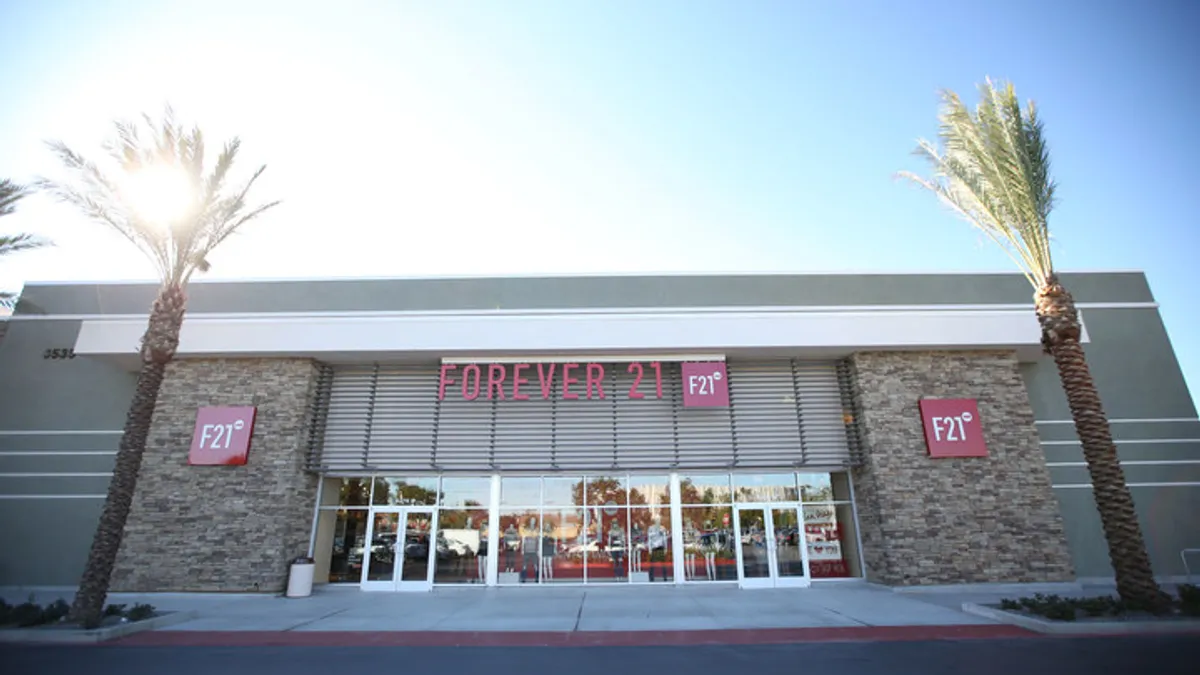Forever 21 has a new lease on life thanks to the successful $81 million bid assembled by the brand conglomerate Authentic Brands Group and the two mall developers that bought it out of bankruptcy.
That's literally true, too — Simon Property Group and Brookfield Property Partners are two of the fast-fashion retailer's major landlords; now they're also two of its major owners, and more stores will likely remain open as a result.
But that doesn't mean that things aren't going to change. In fact, they must if the retailer hopes to reverse the sales and profit declines that drove it to Chapter 11 in the first place. ABG CEO Jamie Salter said as much, noting in a statement regarding the sale that the retailer possesses "a wealth of untapped potential," and promising "new product offerings and experiences."
That's pretty vague, and it's still early days, with the sale official only last week and a new CEO not yet named. But many observers believe that Forever 21, while it must correct some of its own mistakes — including a brick-and-mortar over-expansion, fashion missteps and weak e-commerce — is much like rivals in the space in having to re-think some core attributes of fast fashion. The entire segment faces renewed scrutiny over its high turnover approach as well as new competition, as sales of second-hand clothing rise and off-price continues to take apparel market share. That means that Forever 21's new owners have a major task ahead of them.
"The desire for cheap fast fashion has absolutely waned, and consumers obviously want to invest in better quality and better brands," MKM Partners Managing Director Roxanne Meyer told Retail Dive in an interview. "And they’re interested in sustainability instead of throwing things away. I think the evidence is there with Forever 21’s bankruptcy. Rental, resale, off-price — those good deals for good quality — is a complete contrast to fast fashion."
Fast fashion's sustainability challenge
Shoppers, especially the younger ones who, thanks to their desire to have trendy styles on a budget are most likely to buy fast fashion, are increasingly concerned about sustainability. That's turning them off to the segment, experts say.
A recent Future of Fashion & Retail Consumer Survey from consultancy CGS found that 41% of consumers are turning to secondhand apparel in an effort to save money or find more affordable items, while 13% do so to reduce their environmental impact. Younger consumers are at the forefront, with 64% of Gen Z saying they would pay more for sustainable products, CGS found.
The attitude is likely to become more entrenched, according to Thomai Serdari, a professor of luxury marketing and branding at New York University's Stern School of Business.
"Younger consumers have strong opinions about retailers and how committed each one of them is to making fashion a sustainable industry."

Thomai Serdari
Professor, Luxury Marketing and Branding, NYU's Stern School of Business
"Younger consumers have strong opinions about retailers and how committed each one of them is to making fashion a sustainable industry," she told Retail Dive in an email. "Remarkably, generation Z consumers have strong feelings when it comes to brands and are better informed about their policies and operations than Millennials or Gen X. A new type of consumer with strong ethical standards will hit the market in great numbers in about five years."
H&M and Zara have taken steps to appeal to such consumers. Two years ago, Zara placed sustainability among its four pillars for growth. For a decade now, H&M has released its "Conscious Collection" each spring, using fabrics made with textiles like recycled polyester and plastic, organic cotton, linen and silk, Tencel lyocell (made from sustainably produced wood pulp), Piñatex (vegan leather made from pineapple leaves), Bloom Foam (foam made from algae) and Orange Fiber (made from citrus by-products). In fact, H&M was recently lauded for sustainable cotton sourcing by the World Wildlife Fund, Pesticide Action Network and Solidaridad.
Forever 21 hasn't taken any such steps. That, and the fact that it's unclear whether even the efforts of its rivals can satisfy extremely savvy younger customers, make sustainability an especially steep climb for Forever 21.
"What H&M is doing — they have a huge sustainable attribute," Jordan Nodarse, a fashion designer and founder of Boyish jeans who uses sustainable materials throughout his supply chain, told Retail Dive last year. "If you set apart the sustainable part of H&M, they would probably be the biggest sustainable apparel company in the world. But that is them saying 'we're doing really nice things.'" The reality, he says, is that most of its apparel continues to be unsustainably produced, including the polyester fibers it uses in its eco-collections.
The double bind of e-commerce
Zara and H&M have each signaled their intent to boost e-commerce, while at Forever 21 digital sales remain a weakness. But moving further online could be a double-whammy for younger customers worried about the environment.
Concerns about the additional packaging and carbon emissions from delivery are increasingly on young people's radar, according to Serdari. "While this is still a weak signal, there is considerable reaction against aggressive delivery options that come with fast fashion purchases online," she said. "In other words, how fast fashion and e-commerce evolve has to do both with the ethical implications and moral standing of consumers."
Of course, some shoppers care more than others do, according to Serdari. "Shoppers who are still in college and in a liberal arts curriculum or focus on art and design have left fast fashion behind," she said. "Shoppers in the sciences or business still see fashion as entertainment and tend to spend more [money] on fast fashion."
"We talk about creativity a lot. We put on clothes to express ourselves. But at a shareholders meeting, the visuals you’re looking at are not the innovation of a design but the innovation in business."

Abigail Glaum-Lathbury
Assistant Professor of Fashion Design, School of the Art Institute of Chicago and Designer
That means there are new attitudes among emerging designers too. Abigail Glaum-Lathbury, a designer who teaches fashion design at the School of the Art Institute of Chicago, said that the conversation around sustainability and fashion began to shift some five years ago, and includes the treatment of workers on farms and in factories.
"It has deepened to be really a question of the fashion industry as a whole, and stems from the way that fast fashion has failed all of us," she told Retail Dive in an interview. "We talk about creativity a lot. We put on clothes to express ourselves. But at a shareholders meeting, the visuals you’re looking at are not the innovation of a design but the innovation in business. If you really look at a macro view, there are only so many efficiencies that can be made. What has happened by removing the designer — by prioritizing Wall Street — you have disallowed the designer from being part of that conversation. It has nothing to do what the clothes look like and everything to do with the bottom line."
The new meaning of 'fast' in fashion
Zara is widely credited with launching fast fashion decades ago, spurring a new attitude toward apparel as disposable, as they churned out trendy styles made from inferior fabrics. That challenged the fashion houses that fast-fashion companies were mimicking, pushing them to speed up their own supply chains and, to some extent, break up their traditional timelines.
While the high volume, low-quality turnover in fast fashion may be under scrutiny, the breakdown of seasonal releases may last. Furthermore, the desire for higher quality, longer-lasting clothing is likely behind the rise of apparel rental and resale, according to Paul Magel, president of CGS's business applications division, citing research from the firm's survey.
"Quality is always important — that hasn’t changed in a thousand years. People don’t want to buy garbage, they always want quality at the right price."

Paul Magel
President Business Applications Division, CGS
"Quality is always important — that hasn’t changed in a thousand years. People don’t want to buy garbage, they always want quality at the right price," he told Retail Dive in an interview. "It's that people want what they want, how they want it. But they want to get away from the low quality, throw-away mentality."
Forever 21, notably, has done little to address the emerging demand for sustainable fashion, and it remains to be seen whether its new owners are up to that task. Zara, H&M and others that have taken up the challenge continue to prosper, thanks to their shifts in manufacturing and marketing, Magel said.
But "the devil’s in the details," he also said. Speeding up the supply chain and making it more sustainable can co-exist, but fast fashion needs to appreciate the depth of feeling among consumers. "Even people buying underwear want to make sure it’s sustainable," he said.






















